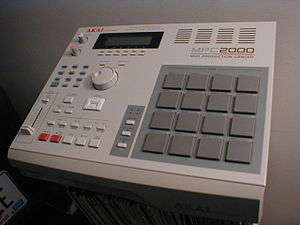
Computer music
Computer music is the application of computing technology in music composition, to help human composers create new music or to have computers independently create music, such as with algorithmic composition programs. It includes the theory and application of new and existing computer software technologies and basic aspects of music, such as sound synthesis, digital signal processing, sound design, sonic diffusion, acoustics, and psychoacoustics. The field of computer music can trace its roots back to the origins of electronic music, and the very first experiments and innovations with electronic instruments at the turn of the 20th century.
In the 2000s, with the widespread availability of relatively affordable home computers that have a fast processing speed, and the growth of home recording using digital audio recording systems ranging from Garageband to Protools, the term is sometimes used to describe music that has been created using digital technology.
History
Much of the work on computer music has drawn on the relationship between music theory and mathematics, a relationship which has been noted since the Ancient Greeks described the "harmony of the spheres". The world's first computer to play music was CSIRAC, which was designed and built by Trevor Pearcey and Maston Beard in the 1950s. Mathematician Geoff Hill programmed the CSIRAC to play popular musical melodies from the very early 1950s. In 1951 it publicly played the "Colonel Bogey March" of which no known recordings exist. However, CSIRAC played standard repertoire and was not used to extend musical thinking or composition practice which is current computer-music practice.
Computer Music (magazine)
Computer Music is a monthly magazine published by Future plc in the UK. It covers the topic of creating digital music on a computer. Each issue once contained a DVD-ROM with samples, plug-ins, software demos, tutorials, and other content related to the issue. Now this content is offered via a download website.
References
External links

Sampler (musical instrument)
A sampler is an electronic musical instrument similar in some respects to a synthesizer, but instead of generating sounds, it uses recordings (or "samples") of sounds that are loaded or recorded into it by the user. These sounds are then played back by means of the sampler program itself, a keyboard, sequencer or another triggering device to perform or compose music. Because these samples are now usually stored in digital memory, the information can be quickly accessed. A single sample may often be pitch-shifted to produce musical scales and chords.
Often samplers offer filters, modulation via low frequency oscillation and other synthesizer-like processes that allow the original sound to be modified in many different ways. Most samplers have polyphonic capabilities - they are able to play more than one note at the same time. Many are also multitimbral - they can play back different sounds simultaneously.
Historical overview
Prior to computer memory-based samplers, musicians used tape replay keyboards, which store recordings on analog tape. When a key is pressed the tape head contacts the moving tape and plays a sound. The Mellotron was the most notable model, used by a number of groups in the late 1960s and the 1970s, but such systems were expensive and heavy due to the multiple tape mechanisms involved, and the range of the instrument was limited to three octaves at the most. To change sounds a new set of tapes had to be installed in the instrument. The emergence of the digital sampler made sampling far more practical.
Podcasts:

